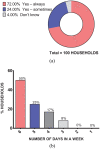Domestic drinking water management: Quality assessment in Oforikrom municipality, Ghana
- PMID: 34407695
- PMCID: PMC10364948
- DOI: 10.1177/00368504211035997
Domestic drinking water management: Quality assessment in Oforikrom municipality, Ghana
Abstract
Drinking water in Ghana is estimated at 79%, but this only represents the proportion of the population with access to improved drinking water sources without regard to the quality of water consumed. This study investigated the quality of household drinking water sources in the Oforikrom municipality where potable water requirements are on the rise due to an ever-increasing population. Both quantitative and qualitative methods were employed in this study. One Hundred households were randomly selected and interviewed on the available options for drinking water and household water treatment and safe storage. A total of 52 points of collection (POC) and 97 points of use (POU) water samples from households were collected for physicochemical and microbial water quality analysis. Amongst the available drinking water options, sachet water (46%) was mostly consumed by households. Water quality analysis revealed that the physicochemical parameters of all sampled drinking water sources were within the Ghana Standards Authority (GSA) recommended values expected for pH (ranging from 4.50 to 7.50). For the drinking water sources, bottled (100%, n = 2) and sachet water (91%, n = 41) showed relatively good microbial water quality. Generally, POC water samples showed an improved microbial water quality in comparison to POU water samples. About 38% (n = 8) of the households practicing water quality management, were still exposed to unsafe drinking water sources. Households should practice good water quality management at the domestic level to ensure access to safe drinking water. This may include the use of chlorine-based disinfectants to frequently disinfect boreholes, wells and storage facilities at homes.
Keywords: Boreholes; HWTS; domestic; sachet water; water safety.
Conflict of interest statement
The author(s) declared no potential conflicts of interest with respect to the research, authorship, and/or publication of this article.
Figures






References
-
- UN Human Rights Council. Resolution adopted by the Human Rights Council 18/1: The human right to safe drinking water and sanitation. A/HRC/RES/18/1. UN General Assembly 2011; 2011: 1–5, http://www2.ohchr.org/english/bodies/hrcouncil/docs/18session/A.HRC.RES.... (2011).
-
- Appiah-Effah E, Duku GA, Azangbego NY, et al.. Ghana’s post-MDGs sanitation situation: an overview. J Water Sanit Hyg Dev 2019; 9: 397–415.
-
- UNDESA. International decade for action: ‘water for life’ 2000–2015. UN Water, 2011.
-
- UN Communications Group (UNCG), CSO Platform. The sustainable development goals (SDGs) in Ghana: why they matter & how we can help. Accra, Ghana, http://gh.one.un.org/content/dam/unct/ghana/docs/SDGs/UNCT-GH-SDGs-in-Gh... (2007, accessed 7 December 2018).
Publication types
MeSH terms
Substances
LinkOut - more resources
Full Text Sources
Medical

